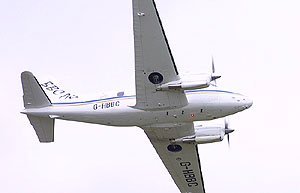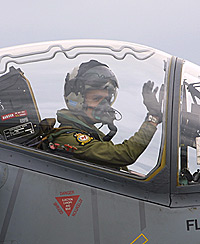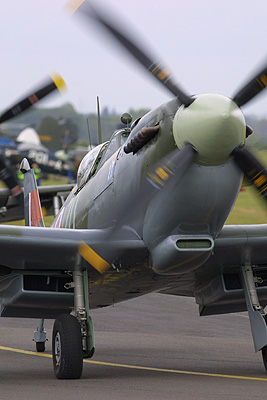 Dark
Grey World
Dark
Grey World
Duxford's Jubilee Airshow, 5 May
Gary Parsons dons mac and woolly hat for the season's opener
It was good to get back to some sense of 'business as usual' in these post-September 11 times. Not only is Duxford planning a full season of airshows, but the weather also ran true to form with low cloud, a chilly northerly wind and intermittent showers to truly welcome in the 2002 season. Duxford seems to have upset the weather gods in the last eighteen months, but it didn't deter a bumper-sized Bank Holiday crowd from enjoying some interesting and varied flying, the numbers undoubtedly swelled by the cancellation of Mildenhall's Air Fete that had been due later in the month.
|
Royal
Review
|
 |
 |
 |
 |
All the Queen's planes…
In Her Majesty's Jubilee year, the show had Royal flying as a main theme. Featuring aircraft types that the Royal Family have flown or flown in over the years, types ranged from the First World War to the present day, including a de Havilland Devon originally piloted by HRH The Duke of Edinburgh. The history of Royal flying dates back more than 80 years to 1917 when the Prince of Wales (later King Edward VIII) became the first member of the Royal Family to fly - when he became King in 1936, he was the first British monarch ever to pilot an aircraft. From 1930 onwards, members of the Royal Family made increasing use of aircraft for travel and in July 1936 the King's Flight was formed as a RAF unit for the sole use of the Royal Family. The King's Flight became The Queen's Flight at Her Majesty's accession and is now known as No.32 (The Royal) Squadron, equipped with BAE 125 and 146 bizjets and contracted helicopters. Unfortunately this latter-day unit was missing from the line-up due to commitments elsewhere.
 Since
1917, many members of the Royal Family have learned to fly. HRH The Duke
of York trained as a Royal Navy helicopter pilot and flew in operations
during the Falklands War in 1982 - the first member of the Royal Family
to see active service since the Second World War. In an unblemished flying
career spanning more than forty years, HRH the Duke of Edinburgh has flown
more aircraft types than most pilots. HRH the Prince of Wales too has
accumulated many hours flying both fixed and rotary-wing aircraft. To
celebrate these achievements, the Devon headed up a small formation called
'Jubilee', joined by Rod Dean in piston Provost XF690
and Radial Revelation's Pembroke WV740. Phil Shaw's Jet Provost XW289
completed the set, representing Prince Charles's time at Cranwell.
Since
1917, many members of the Royal Family have learned to fly. HRH The Duke
of York trained as a Royal Navy helicopter pilot and flew in operations
during the Falklands War in 1982 - the first member of the Royal Family
to see active service since the Second World War. In an unblemished flying
career spanning more than forty years, HRH the Duke of Edinburgh has flown
more aircraft types than most pilots. HRH the Prince of Wales too has
accumulated many hours flying both fixed and rotary-wing aircraft. To
celebrate these achievements, the Devon headed up a small formation called
'Jubilee', joined by Rod Dean in piston Provost XF690
and Radial Revelation's Pembroke WV740. Phil Shaw's Jet Provost XW289
completed the set, representing Prince Charles's time at Cranwell.
Earlier types that had once trained a Royal's joystick included the Shuttleworth Collection's Avro 504K, Bristol Fighter and Avro Tutor, all struggling bravely in the breezy conditions. The Avro's take-off run could not have been more than fifty feet, such was the headwind! The pilot executed a lovely 'falling leaf' manoeuver in the stiff breeze, completely un-noticed by the commentators! The Avro 504K was also celebrating its end of production anniversary - an odd thing to celebrate, but hey, who's complaining when it means flying aeroplanes.
|
Brucie's
price is right
|
|
Brucie the Bear is a House of Lords teddy that was donated by aviation photographer Bob Franklin, a policeman in the Houses of Parliament. For the last four years Bob has managed to get Brucie flying in various aircraft, including the Red Arrows, Battle of Britain Memorial Flight and other fast jet display aircraft. He has travelled the world on peacekeeping missions with the RAF to Sierra Leone, Kosovo and the Middle East, plus enjoyed a tandem free fall parachute jump with the RAF Falcons! Details of these trips have been carefully logged in his own RAF Flying Logbook and the plan is to auction Brucie, together with his logbook, at the end of the year. His exploits will be revealed in a forthcoming children's book called "The flying adventures of Brucie Bear". Proceeds from both these ideas will go to 15(R) Squadron's charity, the Children's Hospice Association Scotland (CHAS). Check out the squadron's website here for more details. |
|
Falklands
fun
|
 |
 |
 |
 |
Corporate entertainment
In the only major commemorative event to mark the 20th anniversary of the Falklands War this year, a salute to 'Operation Corporate' was staged as the opening to the flying.
Helicopters such as Scout, Wasp and Chinook - all of which provided vital and strategic air support for British Forces during the battle for the Falklands - staged an impromptu flypast before separating for individual routines. The RAF provided an operational Puma, Chinook and Merlin, the latter performing its first official in-service public demonstration before an appreciative audience. Surprisingly agile for such a large beast, it belied its 22-metre rotor span with a routine akin to that we would have expected from a Lynx or Gazelle. The Scout and Wasps were privately owned but looked superb, being a credit to their respective owners. One of them was marked 'HMS Endurance', very appropriate in the somewhat Antarctic conditions...and, as the Agentinians operated Pumas during the conflict, maybe it was appropriate the 'enemy' was represented in some way!
 Closing
the show was the RAF's Harrier GR7, sporting a
tail paint scheme similar to last year. A Sea Harrier would have finished
things off nicely, but with the recent announcement of the type's withdrawal
it was no surprise that it was kept out of the spotlight.
Closing
the show was the RAF's Harrier GR7, sporting a
tail paint scheme similar to last year. A Sea Harrier would have finished
things off nicely, but with the recent announcement of the type's withdrawal
it was no surprise that it was kept out of the spotlight.
Veterans honoured
|
Bomber
command performance
|
 |
 |
 |
Another main theme of the show was the 60th anniversary of Bomber Command. Sadly, the weather put paid to the main contributor for this element, the BBMF remaining grounded at Coningsby due to the stiff north-easterly breeze being out of limits. Ably stepping into the void was John Romain and the Blenheim, John putting in some particularly low passes to commemorate the type's honour of opening the batting on 3 September 1939. 'Sally B' then represented the allied 'heavy' effort, and will no doubt be very busy in the next few weeks as the 60th anniversary of the USAAF's arrival in the UK is celebrated - she will be centrepiece of the flypast over Madingley cemetery in Cambridge at the end of the month.
Many Bomber Command veterans were on hand throughout the day to meet members of the public and sign programmes. Douglas Radcliffe MBE, Secretary of the Bomber Command Association said "During the Second World War, when it went into battle, the Air Force flew into fighters, tack - everything, night after night. 55,000 young airmen were killed and those that remain are a dying breed." A parade in front of the descending RAF Falcons team had been planned, but the weather put paid to that idea. Finale for this segment was the RAF's modern-day Bomber Command equivalent, the Tornado GR4 crewed by Flt Lts Colin McGregor and Andi McColl, the latter famous for being the first female fast jet display member and the former for being brother to Obi-won Kenobe (is that how you spell it?).
 Duxford
regulars
Duxford
regulars
|
Fighter
heaven
|
 |
 |
 |
 |
Filling the programme were some old favourites - Carolyn Grace and her Spitfire T9, Pete Kynsey in the Tigercat leading a duo with the Bearcat, and the ubiquitous 'Breitling Fighters' foursome. Two of the latter have received new paint schemes - P-40 NZ3009 now wears the markings of the American Volunteer Group, formed in 1941 under the leadership of General Chennault, (popularly known as the 'Flying Tigers') and P-51D 44-73419 looks simply stunning as 'Ferocious Frankie', the machine of Wallace E. Hopkins who named her in honour of his wife Frankie, coded B7-H of the 374th Fighter Squadron, 361st Fighter Group. It's remarkable how much better a P-51 looks in polished aluminium rather than drab olive green! The foursome, flown by Ray Hanna, Lee Proudfoot, Nigel Lamb and Cliff Spink just found enough cloudbase to perform a routine of loops and low passes. Long may they formate together!
Next up is Flying Legends in July - the weather gods must smile generously soon, the law of averages dictates it!
'Dark Blue World', the forthcoming film about Czech Spitfire pilots in the Battle of Britain, was very much the talk of Duxford's Jubilee Air Display. Much of the filming was done at Duxford. Read more about it here.

